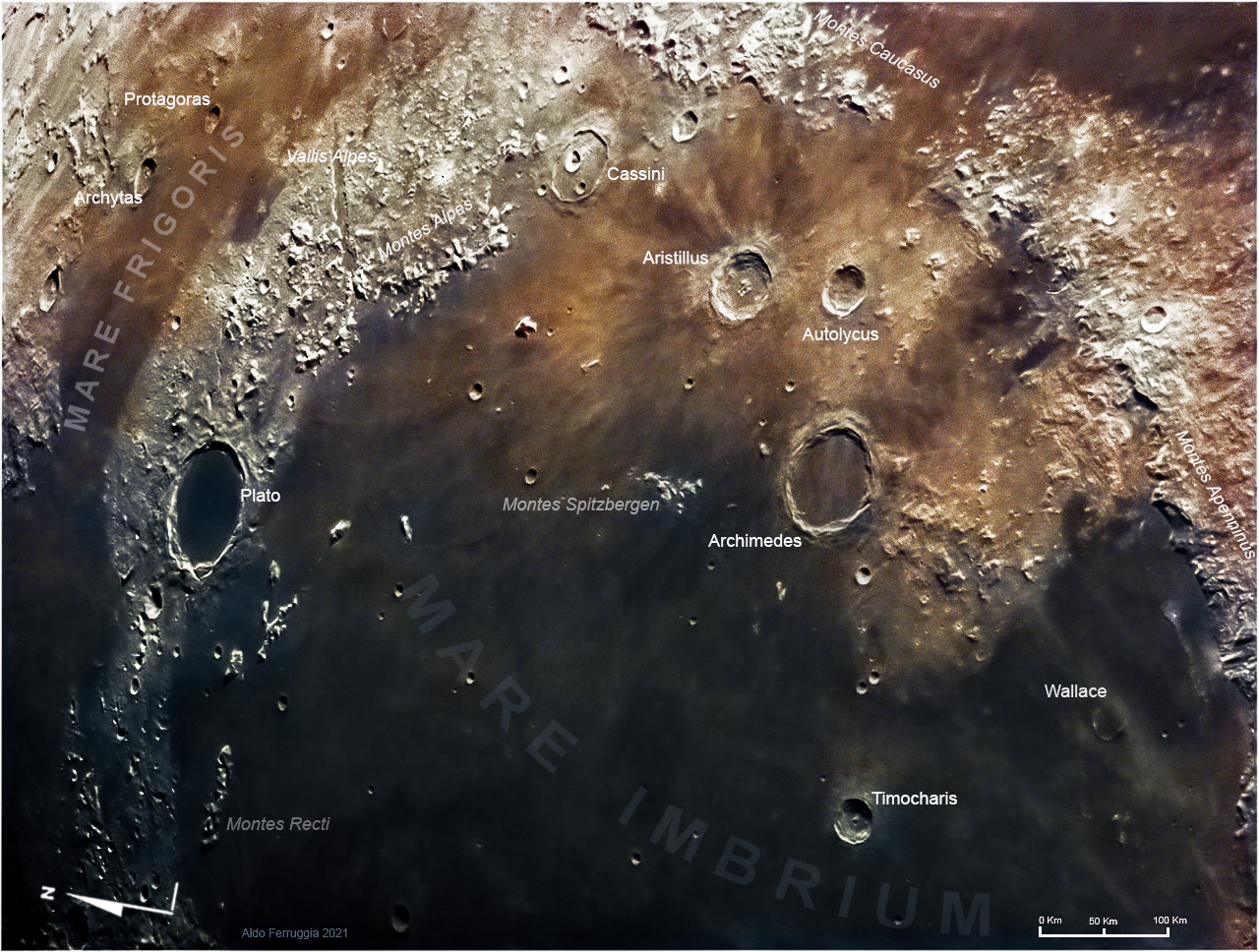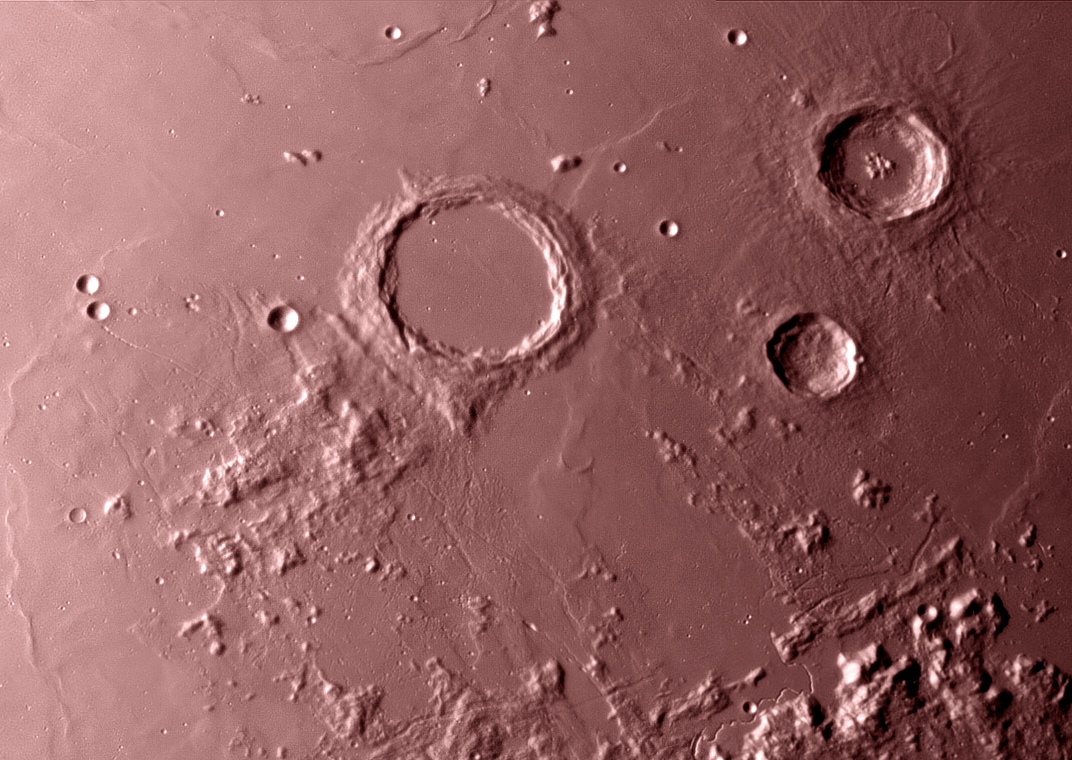Archimedes (crater) on:
[Wikipedia]
[Google]
[Amazon]
Archimedes is a large
 The interior of the crater lacks a central peak, and is flooded with lava. It is devoid of significant raised features, although there are a few tiny meteor craters near the rim. Scattered wisps of bright ray material lie across the floor, most likely deposited by the impact that created Autolycus.
The interior of the crater lacks a central peak, and is flooded with lava. It is devoid of significant raised features, although there are a few tiny meteor craters near the rim. Scattered wisps of bright ray material lie across the floor, most likely deposited by the impact that created Autolycus.

File:Archimedes crater 4115 h1.jpg,
High resolution lunar overflight video
by Seán Doran, based on LRO data, that passes over Archimedes about one third of the way through (se
album
for more) {{DEFAULTSORT:Archimedes (Crater) Impact craters on the Moon Mare Imbrium Archimedes
lunar
Lunar most commonly means "of or relating to the Moon".
Lunar may also refer to:
Arts and entertainment
* ''Lunar'' (series), a series of video games
* "Lunar" (song), by David Guetta
* "Lunar", a song by Priestess from the 2009 album ''Prior t ...
impact crater
An impact crater is a circular depression in the surface of a solid astronomical object formed by the hypervelocity impact of a smaller object. In contrast to volcanic craters, which result from explosion or internal collapse, impact crater ...
on the eastern edges of the Mare Imbrium. Its diameter is 81 km.
Description
The diameter of Archimedes is the largest of any crater on the Mare Imbrium. The rim has a significant outer rampart brightened with ejecta and the upper portion of a terraced inner wall, but lacks the ray system associated with younger craters. A triangular promontory extends 30 kilometers from the southeast of the rim. The interior of the crater lacks a central peak, and is flooded with lava. It is devoid of significant raised features, although there are a few tiny meteor craters near the rim. Scattered wisps of bright ray material lie across the floor, most likely deposited by the impact that created Autolycus.
The interior of the crater lacks a central peak, and is flooded with lava. It is devoid of significant raised features, although there are a few tiny meteor craters near the rim. Scattered wisps of bright ray material lie across the floor, most likely deposited by the impact that created Autolycus.

Surroundings
To the south of Archimedes extends theMontes Archimedes
Montes Archimedes is a mountain range on the Moon. It is named after the nearby crater Archimedes, which in turn is named after the ancient Greek mathematician Archimedes.
This group of mountains is located on a plateau in the eastern part of t ...
, a mountainous region. On the southeastern rim is the Palus Putredinis, a lava-flooded plain containing a system of rille
Rille (German for 'groove') is typically used to describe any of the long, narrow depressions in the surface of the Moon that resemble channels. The Latin term is ''rima'', plural ''rimae''. Typically, a rille can be several kilometers wi ...
s named the Rimae Archimedes, which extends over 150 kilometers. North-northwest of Archimedes stand the Montes Spitzbergen
The Montes Spitzbergen (Spitzbergen Mountains) is a solitary mountain chain in the eastern Mare Imbrium of the Moon. It is located about 80 km to the north of the flooded crater Archimedes. The range trends from south to north, consisting ...
, a string of peaks in the Mare Imbrium. East of Archimedes is the crater Autolycus. Northeast of Archimedes is the prominent crater Aristillus. The lava plain between Archimedes, Aristillus, and Autolycus forms the Sinus Lunicus bay of Mare Imbrium. A wrinkle ridge leads away from Archimedes toward the north-northwest, crossing this mare
A mare is an adult female horse or other equine. In most cases, a mare is a female horse over the age of three, and a filly is a female horse three and younger. In Thoroughbred horse racing, a mare is defined as a female horse more than fo ...
.
Names
Archimedes is named after the Greek scientist Archimedes. Like many of the craters on the Moon's near side, it was given its name byGiovanni Riccioli
Giovanni Battista Riccioli, SJ (17 April 1598 – 25 June 1671) was an Italian astronomer and a Catholic priest in the Jesuit order. He is known, among other things, for his experiments with pendulums and with falling bodies, for his discussion ...
, whose 1651 nomenclature system has become standardized. Earlier lunar cartographers had given the feature different names. Michael van Langren's 1645 map calls it "Roma" after the city of Rome
, established_title = Founded
, established_date = 753 BC
, founder = King Romulus (legendary)
, image_map = Map of comune of Rome (metropolitan city of Capital Rome, region Lazio, Italy).svg
, map_caption ...
. Johannes Hevelius
Johannes Hevelius
Some sources refer to Hevelius as Polish:
*
*
*
*
*
*
*
Some sources refer to Hevelius as German:
*
*
*
*
*of the Royal Society
* (in German also known as ''Hevel''; pl, Jan Heweliusz; – 28 January 1687) was a councillor ...
called it "Mons Argentarius" after Monte Argentario
Monte Argentario is a ''comune'' (municipality) and a peninsula belonging to the Province of Grosseto in the Italian region Tuscany, located about south of Florence and about south of Grosseto. The peninsula is connected with the mainland by thre ...
region in Italy
Italy ( it, Italia ), officially the Italian Republic, ) or the Republic of Italy, is a country in Southern Europe. It is located in the middle of the Mediterranean Sea, and its territory largely coincides with the homonymous geographical ...
.
Exploration
The stretch of lunar surface between Archimedes and Autolycus was the site of the crash-landing of theSoviet
The Soviet Union,. officially the Union of Soviet Socialist Republics. (USSR),. was a transcontinental country that spanned much of Eurasia from 1922 to 1991. A flagship communist state, it was nominally a federal union of fifteen nation ...
probe Luna 2. This was the first craft to reach the surface of the Moon, landing September 13, 1959.
Satellite craters
By convention these features are identified on lunar maps by placing the letter on the side of the crater midpoint that is closest to Archimedes. The following craters have been renamed by theIAU
The International Astronomical Union (IAU; french: link=yes, Union astronomique internationale, UAI) is a nongovernmental organisation with the objective of advancing astronomy in all aspects, including promoting astronomical research, outreach ...
.
* Archimedes A - ''See'' Bancroft (crater).
* Archimedes F - ''See'' MacMillan (crater)
MacMillan is a bowl-shaped lunar impact crater on the eastern fringes of the Mare Imbrium. It was named after American mathematician and astronomer William Duncan MacMillan. It is located just to the southwest of a lone rise, near the southwester ...
.
* Archimedes K - ''See'' Spurr (crater).
Gallery
Lunar Orbiter 4
Lunar Orbiter 4 was a robotic U.S. spacecraft, part of the Lunar Orbiter Program, designed to orbit the Moon, after the three previous orbiters had completed the required needs for Apollo mapping and site selection. It was given a more general ...
image
File:Imbrium map.png, Detail map of Mare Imbrium's features. Archimedes is the feature marked "G".
File:M119883761 Archimedes LROC.png, LRO image of the contact of the crater wall (lower left) and the floor (upper right)
References
* * * * * * * * * * *External links
*High resolution lunar overflight video
by Seán Doran, based on LRO data, that passes over Archimedes about one third of the way through (se
album
for more) {{DEFAULTSORT:Archimedes (Crater) Impact craters on the Moon Mare Imbrium Archimedes